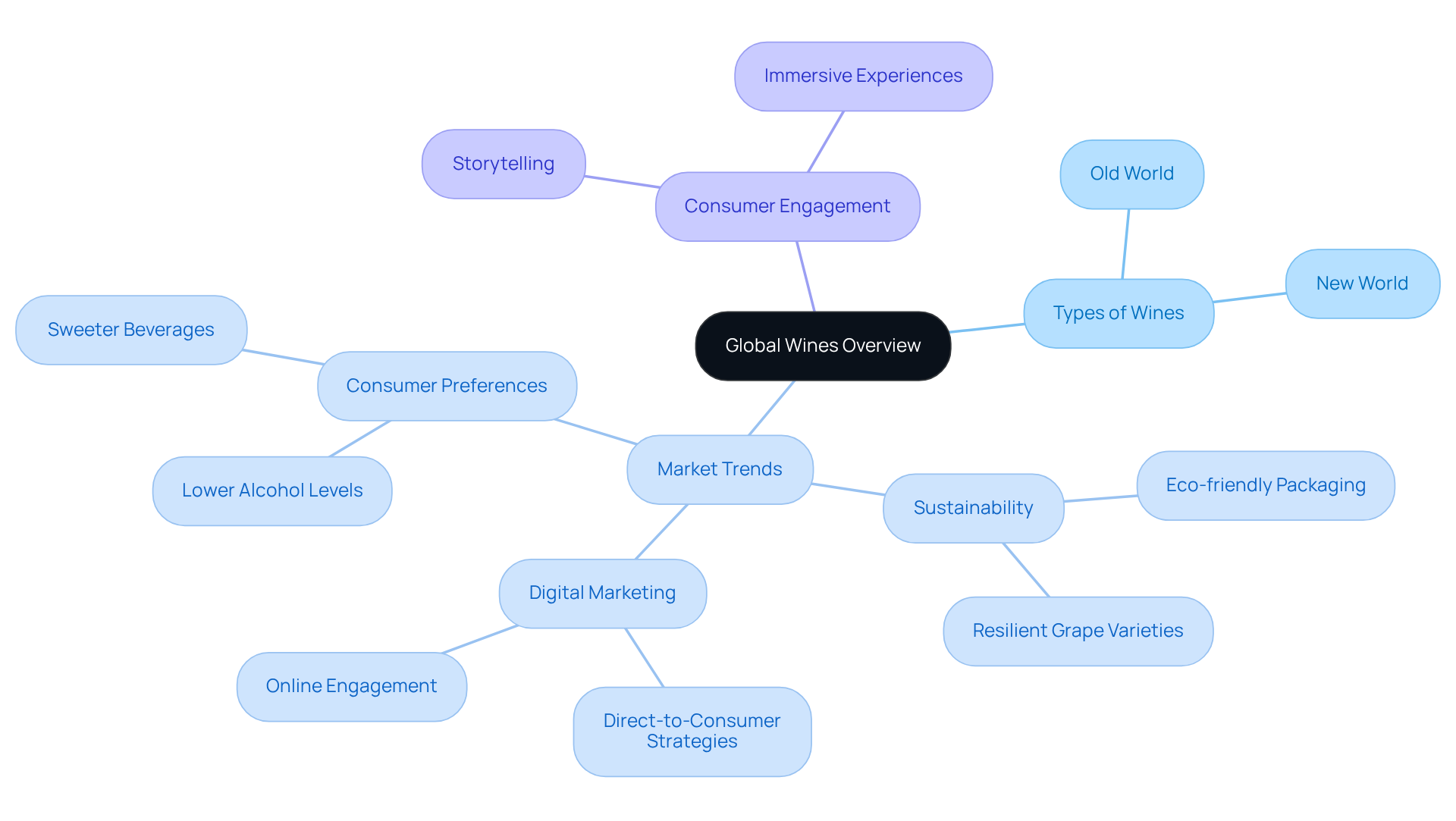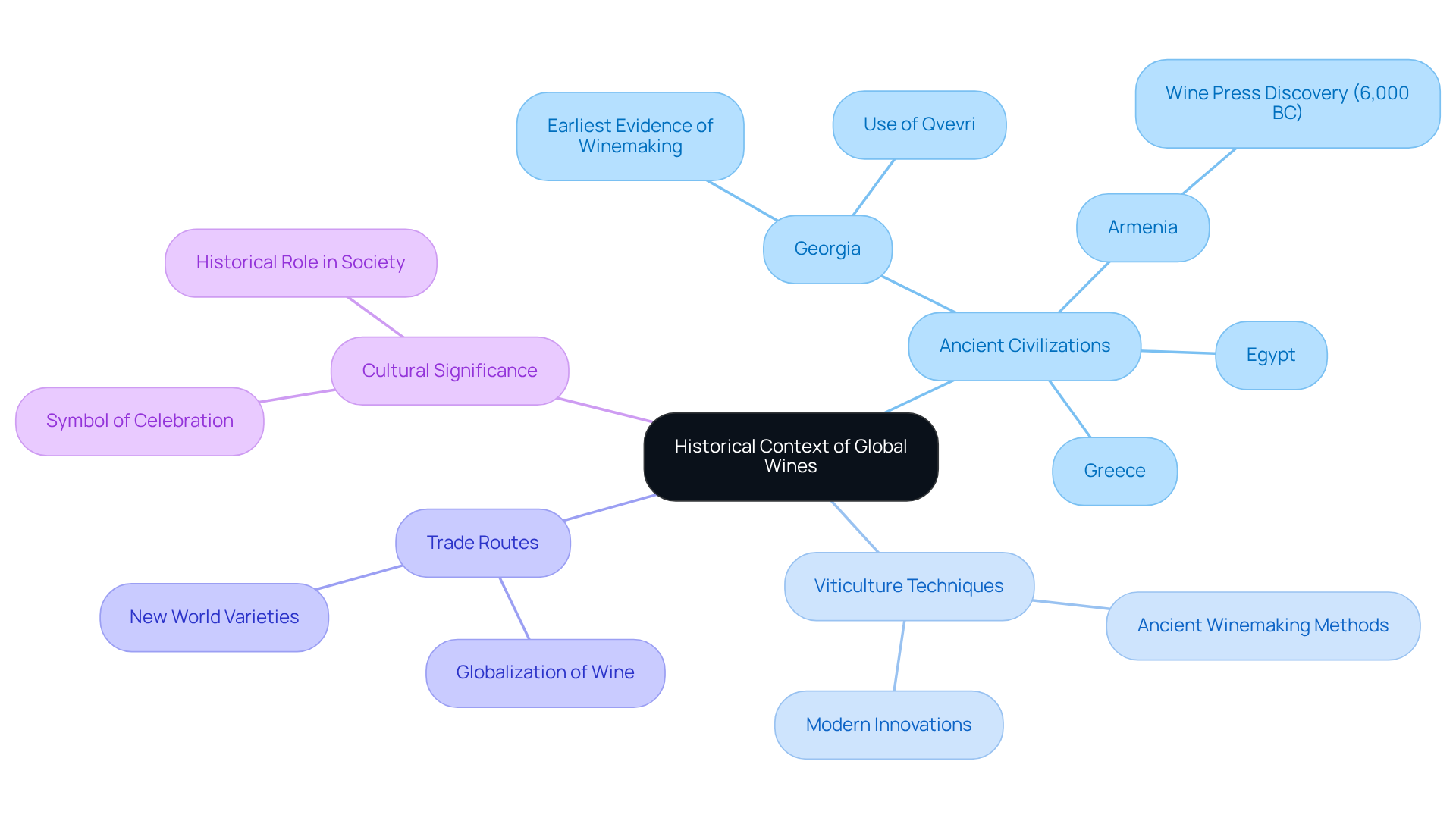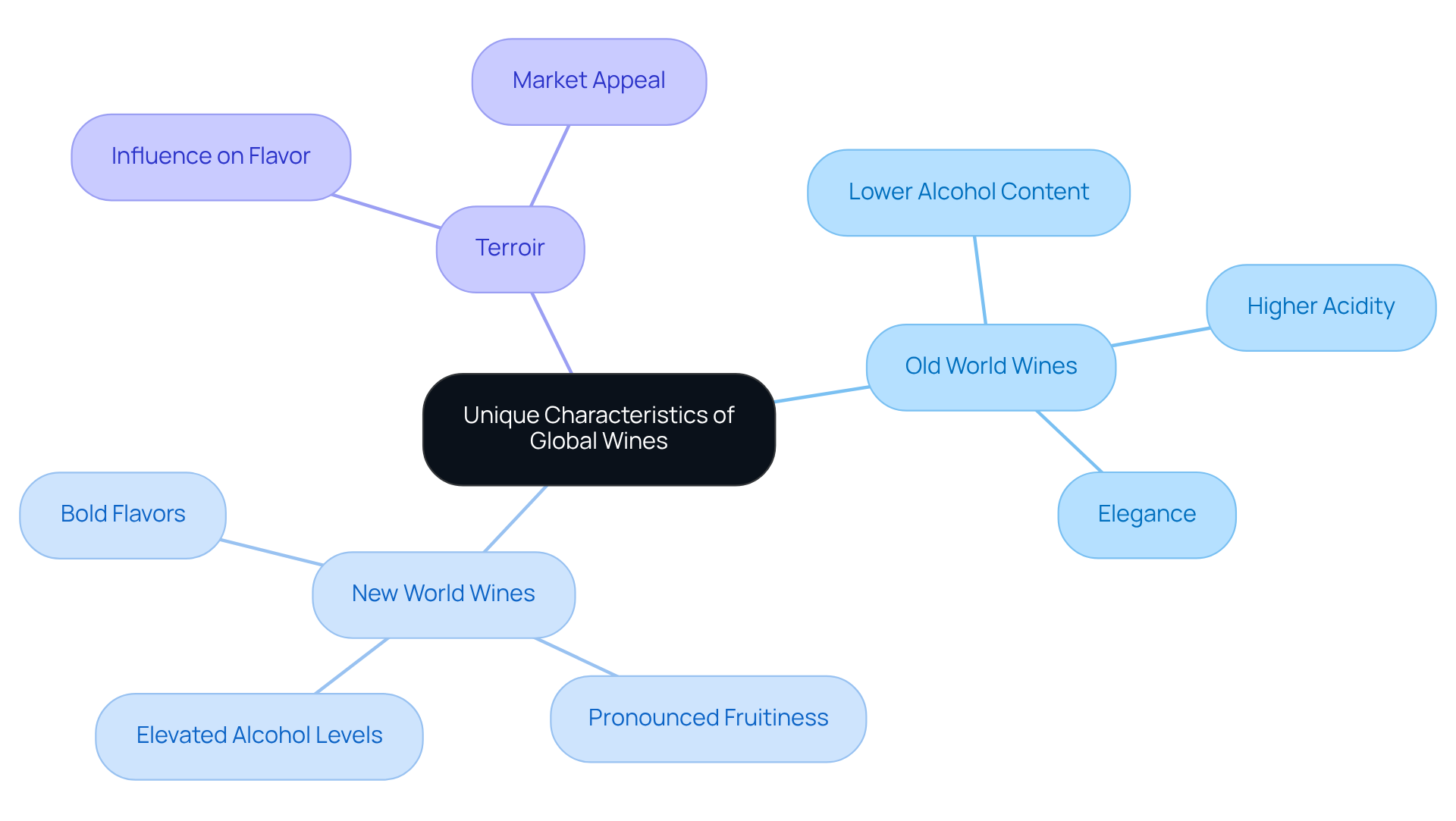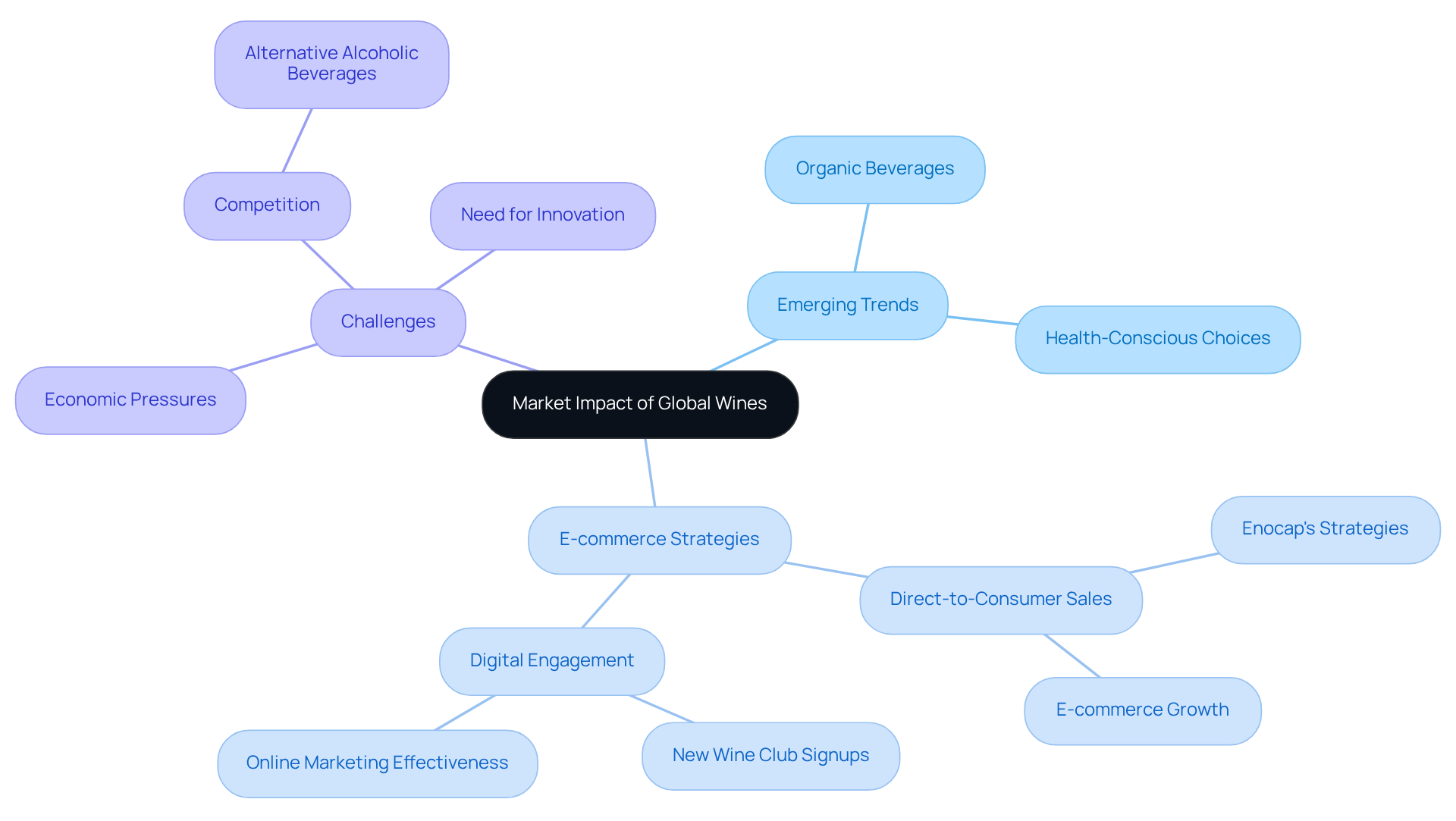Overview
This article delves into the rich history, distinctive characteristics, and significant market impact of global wines, underscoring their diverse origins and the evolving preferences of consumers. It asserts that the expansion of the global wine market is propelled by a growing emphasis on sustainability and innovative marketing strategies. Furthermore, it highlights the critical role of storytelling in forging connections with consumers, an essential aspect for wineries striving to succeed in a competitive landscape.
Introduction
Global wines embody a rich tapestry of history and diversity, reflecting the unique terroirs and winemaking traditions from regions around the globe. As the beverage market evolves, the significance of these wines extends beyond mere consumption; they represent cultural heritage, economic impact, and shifting consumer preferences.
How can wineries leverage this intricate landscape to connect with modern buyers while navigating the challenges of sustainability and innovation?
Exploring the fascinating journey of global wines reveals not only the complexities of their characteristics but also the dynamic forces shaping their future in the marketplace. This exploration is not just an academic exercise; it is a call to action for industry stakeholders to adapt and thrive in an ever-changing environment.
Define Global Wines: An Overview
Global wines represent a diverse array of beverages crafted across various regions worldwide, each reflecting unique characteristics shaped by local grape varieties, terroir, and winemaking traditions. This category includes both Old World varieties from established European regions and selections of global wines from New World countries such as the United States, Australia, and South America. The global beverage sector is steeped in rich history and cultural significance, playing a crucial role in the economy and contributing significantly to the industry.
By 2025, the worldwide beverage market is projected to reach approximately 48 million hectoliters, indicating a consistent growth rate driven by shifting buyer preferences and innovative marketing strategies. Successful direct-to-consumer (DTC) approaches have become essential, with wineries increasingly leveraging digital channels to enhance customer engagement. Notably, 27% of new club signups now originate from online platforms, underscoring the necessity of a robust digital presence.
Current trends in global wines indicate a shift towards sustainability and innovation, as wineries adapt to climate challenges and changing buyer behaviors. The emergence of and the introduction of resilient grape varieties exemplify how the industry is responding to these pressures. Furthermore, the rising popularity of sweeter beverages with lower alcohol levels is attracting new demographics, particularly younger consumers who prioritize convenience and sustainability.
Expert insights emphasize the significance of storytelling and brand narratives in differentiating beverages within a competitive marketplace. As the industry navigates these transformative changes, the ability to connect with consumers through compelling narratives and innovative practices will be vital for achieving long-term success.

Explore the Historical Context of Global Wines
The history of global beverages spans millennia, with archaeological evidence tracing production back to regions like Georgia, Armenia, and Iran, as early as 6000 BC. The finding of pottery jars in Neolithic settlements such as Gadachrili Gora and Shulaveris Gora indicates chemical evidence of fermented beverages, implying among ancient cultures. Notably, the earliest evidence of grape winemaking was discovered in 8,000-year-old pottery fragments, underscoring a long-standing tradition of viticulture.
Civilizations like the Egyptians and Greeks significantly advanced viticulture, sharing techniques that would shape the industry. The Roman Empire played a crucial role in expanding grape production throughout Europe, establishing vineyards that laid the groundwork for today’s renowned regions for this beverage.
As David Lordkipanidze, director of the Georgian National Museum, observes, large jars called qvevri, akin to the ancient ones, are still employed for winemaking in Georgia, highlighting the continuity of winemaking techniques from ancient to modern times.
As trade routes evolved, globalization transformed the beverage landscape, giving rise to New World varieties and fostering a diverse market for global wines that continues to adapt and thrive. This evolution reflects not only the cultural significance of this beverage but also its enduring appeal as a symbol of celebration and heritage.
Furthermore, the world's earliest non-grape-based beverage, believed to be a fermented drink made from rice, honey, and fruit from China around 7,000 BC, illustrates the diversity of early production methods.

Identify Unique Characteristics of Global Wines
Global wines showcase a diverse array of traits shaped by climate, soil, and grape varieties. Old World beverages, renowned for their elegance, typically present lower alcohol content and higher acidity, resulting in a refined taste profile. Conversely, New World beverages are distinguished by bolder flavors, pronounced fruitiness, and elevated alcohol levels, reflecting a distinct production approach. The concept of terroir—encompassing the unique environmental conditions of a vineyard—plays a crucial role in defining these flavor profiles.
For example, in the Upper Hemel-en-Aarde Valley merges traditional techniques with contemporary innovation, producing wines that authentically reflect their terroir.
As we look towards 2025, current trends indicate a burgeoning appreciation for the complexity and diversity of flavors in global wines, with consumers increasingly drawn to beverages that tell a story of their origin. This shift underscores the importance of terroir in influencing not only flavor but also the market appeal of vintages.
Wineries have the opportunity to leverage their unique characteristics through compelling brand narratives and strategic direct-to-consumer approaches, transforming casual buyers into dedicated club members. Proven strategies have shown that wineries can achieve up to 191% e-commerce growth, underscoring the significance of effective storytelling and customer connection.
As the beverage sector evolves, understanding these distinctions will be vital for wineries aiming to enhance their brand narratives and refine their direct-to-consumer strategies.

Assess the Market Impact of Global Wines
The international beverage market represents a multi-billion dollar sector poised for significant growth, driven by evolving consumer preferences and the emergence of new markets. Current trends indicate a marked shift towards organic and sustainable beverages, as consumers increasingly prioritize health and environmental considerations. This transformation is underscored by data showing that the , highlighting the escalating demand for products that resonate with these values.
E-commerce has revolutionized the marketing and sales landscape for beverages, enabling wineries to establish direct-to-consumer sales channels that enhance their connection with buyers. Enocap's strategies have led to an impressive 153% increase in e-commerce order volume during expansions, illustrating the efficacy of adapting to digital sales platforms. Additionally, 27% of new beverage club registrations now originate from digital sources, underscoring the importance of online engagement in capturing market share.
However, the sector also confronts challenges such as:
- Economic pressures
- Competition from alternative alcoholic beverages
- The imperative for ongoing innovation to satisfy shifting consumer demands
The rise of organic and sustainable beverages is not merely a passing trend; it reflects a broader transformation in consumer behavior, with an increasing segment of the industry pursuing products that are both environmentally responsible and health-conscious. As the global wines market continues to evolve, it remains a dynamic and influential component of the broader beverage industry, necessitating strategic approaches to navigate its complexities.

Conclusion
Global wines represent a rich tapestry of beverages that embody the unique characteristics of their regions, influenced by local grape varieties and winemaking traditions. This diversity encompasses both Old World and New World varieties, underscoring the cultural significance and economic impact of the wine industry worldwide. As the market continues to expand, it becomes essential for both producers and consumers to grasp the nuances of global wines.
The historical context of global wines reveals their origins dating back thousands of years, showcasing how ancient civilizations laid the foundation for modern viticulture. The distinct characteristics of Old World and New World wines are examined, with an emphasis on the role of terroir and the shifting consumer preferences that are propelling trends towards sustainability and innovation. Furthermore, the significance of digital marketing and direct-to-consumer strategies emerges as vital for wineries aiming to thrive in an increasingly competitive landscape.
As we approach 2025, the global wines market highlights that adaptability and storytelling will be pivotal in capturing the attention of a new generation of consumers. The movement towards organic and sustainable practices mirrors broader societal trends, making it imperative for the wine industry to align with these values. Embracing these changes not only enhances market appeal but also secures the enduring legacy of global wines within a rapidly evolving environment.
Frequently Asked Questions
What are global wines?
Global wines are a diverse range of beverages produced in various regions around the world, characterized by local grape varieties, terroir, and winemaking traditions. This includes both Old World wines from established European regions and New World wines from countries like the United States, Australia, and South America.
What is the projected growth of the global beverage market by 2025?
The global beverage market is projected to reach approximately 48 million hectoliters by 2025, reflecting a consistent growth rate driven by changing buyer preferences and innovative marketing strategies.
How are wineries adapting to the changing market?
Wineries are increasingly adopting direct-to-consumer (DTC) approaches, leveraging digital channels for customer engagement. Notably, 27% of new club signups now come from online platforms, highlighting the importance of a strong digital presence.
What trends are currently influencing global wines?
Current trends include a shift towards sustainability and innovation, with wineries responding to climate challenges and changing consumer behaviors. This includes eco-friendly packaging and the introduction of resilient grape varieties.
Which demographics are influencing the popularity of global wines?
The rising popularity of sweeter beverages with lower alcohol levels is attracting new demographics, particularly younger consumers who prioritize convenience and sustainability.
Why is storytelling important in the global wine market?
Storytelling and brand narratives are crucial for differentiating beverages in a competitive marketplace. Connecting with consumers through compelling narratives and innovative practices is vital for long-term success in the industry.




